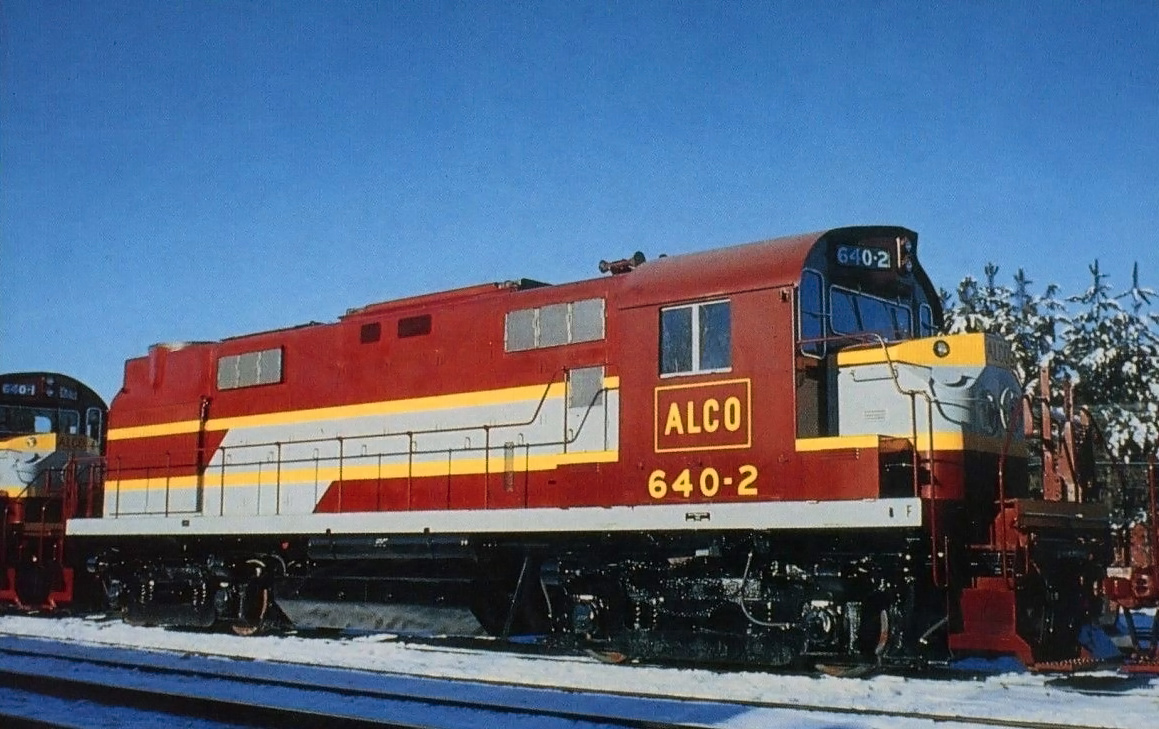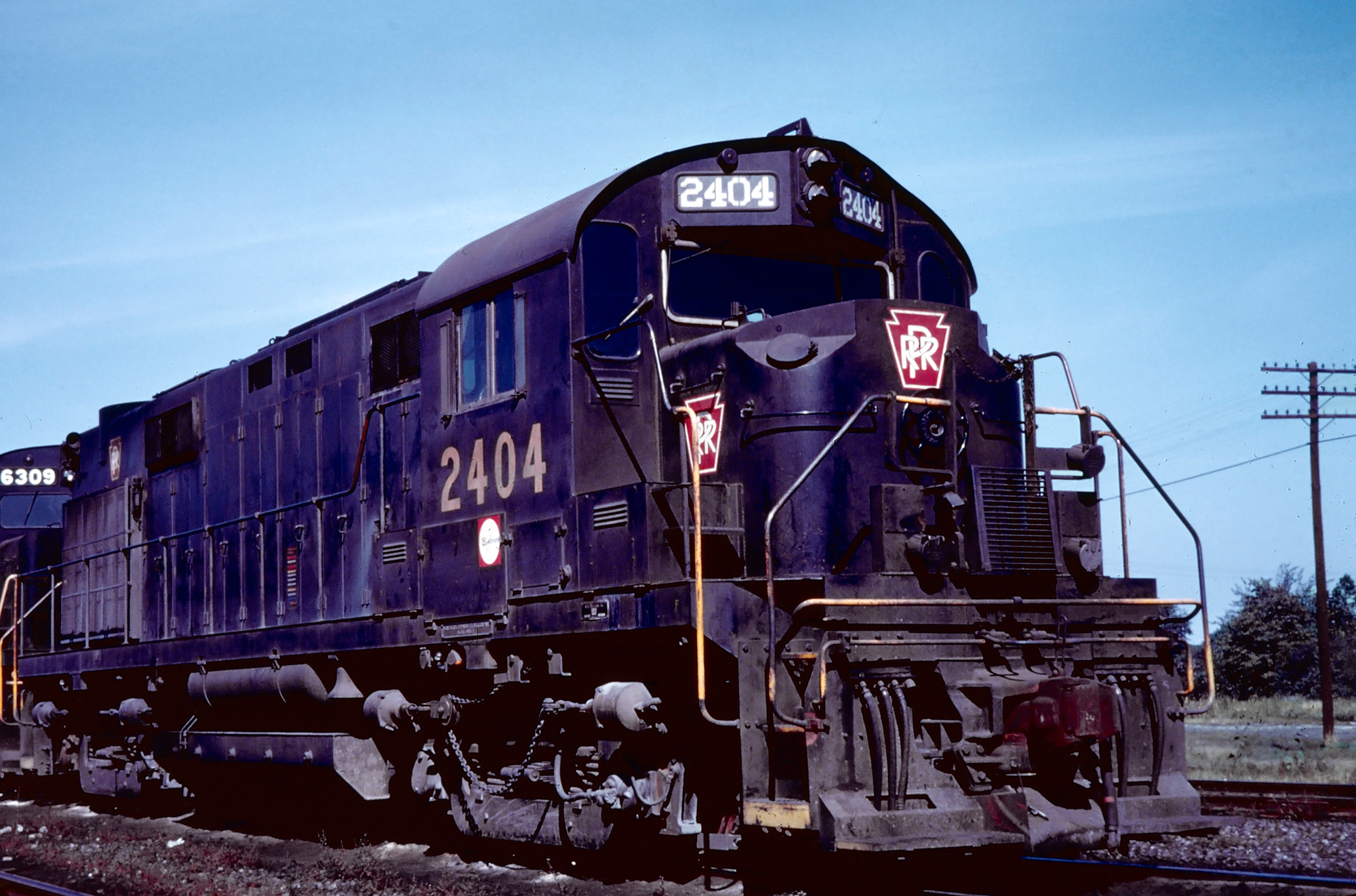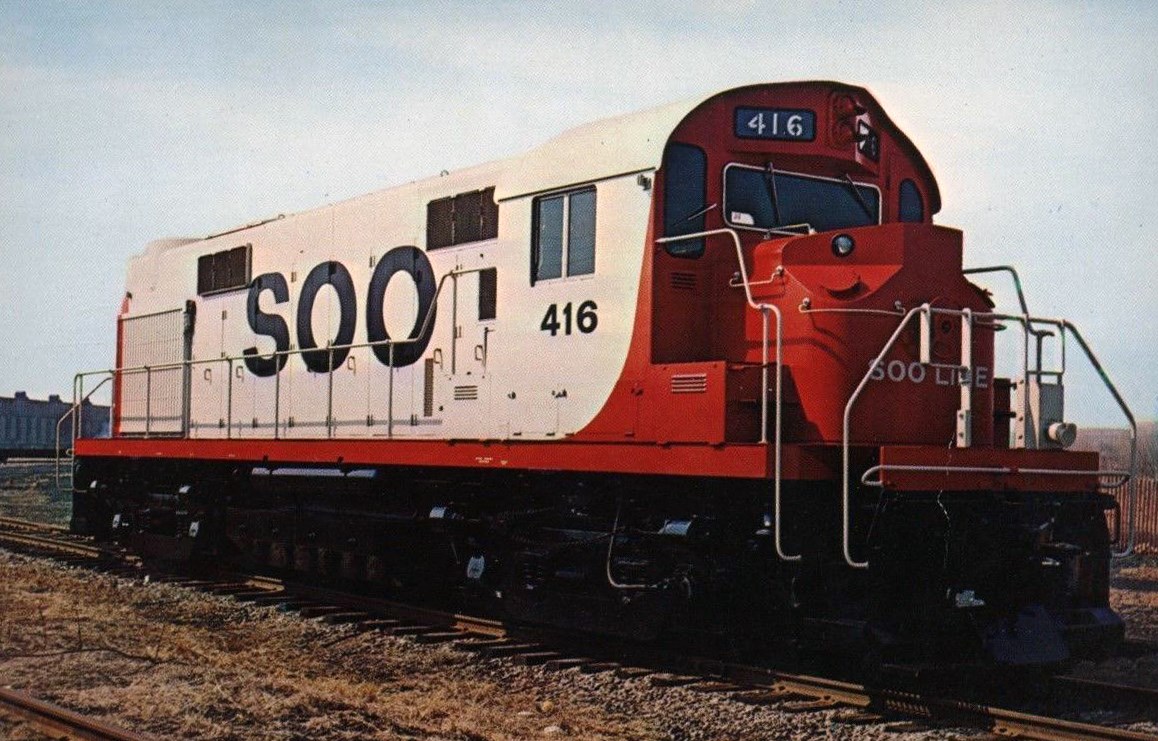Alco "RS27" Locomotives: Specs, Roster, Data Sheet
Last revised: December 27, 2024
By: Adam Burns
The RS27 was a late model of the Road Switcher (RS) series that
produced more than 2,000 horsepower. However, the model was
unsuccessful, a common theme of Alco production during this time.
The RS27 looked very much like Alco's later models and was the first to receive the builder's new styling. By the late 1950s Alco was slipping further behind the Electro-Motive Division
Overview
Alas, before the decade was over it would also be competing with one-time ally General Electric. Interestingly, examples of this rare Alco model can still be found, in service on short line Minnesota Commercial (a haven for Alcos).
The locomotives were purchased from the Green Bay & Western, which had purchased them from the Chicago & North Western (#901 and #903). Aside from RS27's, their roster over the years has included RS3's, C424's, and even Montreal builds (RS18's, RS23's, M630's, and M636's).
Photos
 A pair of Alco's RS27 demonstrators, #640-2 and #640-1, circa 1959. The lead unit (#640-2) became Union Pacific #675 while the trailing unit (#640-1) was sold to the Pennsylvania and became #2415. The three other demonstrators (#640-3 - #640-5) were also acquired by UP becoming #676-678. George Hockaday photo.
A pair of Alco's RS27 demonstrators, #640-2 and #640-1, circa 1959. The lead unit (#640-2) became Union Pacific #675 while the trailing unit (#640-1) was sold to the Pennsylvania and became #2415. The three other demonstrators (#640-3 - #640-5) were also acquired by UP becoming #676-678. George Hockaday photo.The RS27 began production in 1959 using a B-B format (two axles per truck) and producing a hefty 2,400 horsepower for a somewhat small, four-axle unit.
As with other late-model RS designs the RS27 came in a standard low-nose setup using Alco's much more reliable 251B prime mover.
Design
In terms of the company's history as a locomotive builder, the RS27 offered the first glimpse of its Century series, which began production in 1963. The model retained the flush, long hood with the cab and the classic notched corners on the carbody remained.
However, the cab featured a slight design change with raised number boards and headlights, and the nose was shorter giving the locomotive a more blunted appearance.
From an exterior standpoint the RS27 began the common look of second-generation designs, as GE used a similar setup with its U25B, and EMD did the same beginning with its GP18, GP20,and GP30 models.
Perhaps it was due to Alco's earlier troublesome engine designs that kept railroads away but whatever the case the builder found little success with the RS27 selling less than thirty units with the Pennsylvania Railroad purchasing the most (15). The year 1959 was not a particularly good one for Alco.
It was increasingly losing market share to EMD, had not cataloged a successful locomotive since the RS3 finished production in 1956 (although its RS11 design did sell relatively well).
 Pennsylvania RS27 #2404 is seen here near Chicago, circa 1965. Fred Byerly photo. American-Rails.com collection.
Pennsylvania RS27 #2404 is seen here near Chicago, circa 1965. Fred Byerly photo. American-Rails.com collection.Additionally, that year GE ended its five decade partnership with the company when it released its own line of diesels beginning with the U25B (which ironically far outsold the RS27).
From an operational standpoint, the RS27 varied little from the RS11 aside from the additional horsepower. It actually offered less continuous tractive effort (42,000 pounds) but more starting effort (66,000 pounds).
As had been the case for nearly two decades when the RS27 was produced, internal components like traction motors, generators, and air brakes/compressors came in from GE and Westinghouse.
Data Sheet and Specifications
| Alco Class | 404-DL-257 |
| Entered Production | 12/1959 (Demo #640-1) |
| Years Produced | 12/1959-10/19/1962 |
| Model Specification | DL640 |
| Engine | 251B, V-16 |
| Horsepower | 2,400 |
| RPM | 1,025 |
| Carbody Styling | Alco |
| Length (Between Coupler Pulling Faces) | 57' 2" |
| Weight | 256,800 Lbs. |
| Dynamic Brakes | Optional |
| Trucks | B-B |
| Truck Type | Swing Bolster, Drop-Side Equalizer (AAR Type-B) |
| Truck Wheelbase | 9' 4" |
| Wheel Size | 40" |
| Traction Motors | GE 752 (4) |
| Traction Generator | GT581 |
| Steam Generator | Optional |
| Gear Ratio | 65:18 |
| Tractive Effort Rating | 64,200 Lbs. |
| Top Speed | 75 MPH |
Production Roster
Total Built = 27
| Owner | Road Number(s) | Construction Number(s) | Completion Date |
|---|---|---|---|
| Alco Demonstrator * | 640-1, 640-2, 640-3, 640-4, 640-5 (Demo's #640-2 thru #640-5 to Union Pacific) | 83555-83559 | 12/1959-1/1960 |
| Chicago & North Western | 900-903 | 83601-83604 | 3/1962 |
| Green Bay & Western | 310 | 83600 | 11/1960 |
| Pennsylvania | 2400-2407 | 83607-83614 | 10/1962 |
| Pennsylvania | 2408-2414 | 84373-84379 | 10/1962 |
| Soo Line | 415-416 | 83605-83606 | 4/1962 |
| Union Pacific | 675-678 (Ex-Demo's #640-2 thru #640-5) | 4 | 12/1959-1/1960 |
* The first demonstrator, #640-1, was returned to Schenectady and rebuilt as a C424 and assigned new construction number 84558. It was subsequently sold to the Pennsylvania Railroad on October 1, 1963 as #2415.
Sources
- Foster, Gerald. A Field Guide To Trains. New York: Houghton Mifflin, 1996.
- Kirkland, John F. Diesel Builders, The: Volume Two, American Locomotive Company And Montreal Locomotive Works. Glendale: Interurban Press, 1989.
- Pinkepank, Jerry A. Diesel Spotter's Guide. Milwaukee: Kalmbach Publishing Company, 1967.
- Solomon, Brian. Alco Locomotives. Minneapolis: Voyageur Press, 2009.
 An American Locomotive builder's photo at its Schenectady plant featuring one of the Soo Line's two RS27's (#415) it purchased in 1962.
An American Locomotive builder's photo at its Schenectady plant featuring one of the Soo Line's two RS27's (#415) it purchased in 1962.Reception
In the end the model proved another abysmal failure for Alco as just four Class I railroads ultimately purchased the RS27; the aforementioned Pennsylvania, Soo Line, Chicago & North Western, and Green Bay & Western.
Of note, however, Union Pacific did purchase two of the demonstrators, #640-2 and #640-3. Somewhat unsatisfied, UP returned them to the Montreal Locomotive Works where they were later resold.
Today, the Minnesota Commercial is apparently quite happy with its two RS27s as the railroad has kept them on its roster for nearly three decades now.
Recent Articles
-
Montana Dinner Train Rides Near Lewistown!
Jan 08, 26 03:03 PM
The Charlie Russell Chew Choo turns an ordinary rail trip into an evening event: scenery, storytelling, live entertainment, and a hearty dinner served as the train rumbles across trestles and into a t… -
Alabama's - Murder Mystery - Dinner Train Rides
Jan 08, 26 02:19 PM
There is currently one location in the state offering a murder mystery dinner experience, the Wales West Light Railway! -
Rhode Island's - Murder Mystery - Dinner Train Rides
Jan 08, 26 01:43 PM
Let's dive into the enigmatic world of murder mystery dinner train rides in Rhode Island, where each journey promises excitement, laughter, and a challenge for your inner detective. -
Florida's - Wine Tasting - Train Rides
Jan 08, 26 01:13 PM
Wine by train not only showcases the beauty of Florida's lesser-known regions but also celebrate the growing importance of local wineries and vineyards. -
Texas's - Wine Tasting - Train Rides
Jan 08, 26 12:30 PM
This article invites you on a metaphorical journey through some of these unique wine tasting train experiences in Texas. -
New York's - Wine Tasting - Train Rides
Jan 08, 26 11:32 AM
This article will delve into the history, offerings, and appeal of wine tasting trains in New York, guiding you through a unique experience that combines the romance of the rails with the sophisticati… -
California Dinner Train Rides In Sacramento!
Jan 08, 26 11:21 AM
Just minutes from downtown Sacramento, the River Fox Train has carved out a niche that’s equal parts scenic railroad, social outing, and “pick-your-own-adventure” evening on the rails. -
New Jersey Dinner Train Rides In Woodstown!
Jan 08, 26 10:31 AM
For visitors who love experiences (not just attractions), Woodstown Central’s dinner-and-dining style trains have become a signature offering—especially for couples’ nights out, small friend groups, a… -
Nevada's - Murder Mystery - Dinner Train Rides
Jan 07, 26 02:12 PM
Seamlessly blending the romance of train travel with the allure of a theatrical whodunit, these excursions promise suspense, delight, and an unforgettable journey through Nevada’s heart. -
West Virginia's - Murder Mystery - Dinner Train Rides
Jan 07, 26 02:08 PM
For those looking to combine the allure of a train ride with an engaging whodunit, the murder mystery dinner trains offer a uniquely thrilling experience. -
Kansas's - Murder Mystery - Dinner Train Rides
Jan 07, 26 01:53 PM
Kansas, known for its sprawling wheat fields and rich history, hides a unique gem that promises both intrigue and culinary delight—murder mystery dinner trains. -
Michigan's - Wine Tasting - Train Rides
Jan 07, 26 12:36 PM
In this article, we’ll delve into the world of Michigan’s wine tasting train experiences that cater to both wine connoisseurs and railway aficionados. -
Indiana's - Wine Tasting - Train Rides
Jan 07, 26 12:33 PM
In this article, we'll delve into the experience of wine tasting trains in Indiana, exploring their routes, services, and the rising popularity of this unique adventure. -
South Dakota's - Wine Tasting - Train Rides
Jan 07, 26 12:30 PM
For wine enthusiasts and adventurers alike, South Dakota introduces a novel way to experience its local viticulture: wine tasting aboard the Black Hills Central Railroad. -
Kentucky Thomas The Train Rides
Jan 07, 26 12:26 PM
If you’ve got a Thomas fan in the house, Day Out With Thomas at the Kentucky Railway Museum is one of those “circle it on the calendar” weekends. -
Michigan's Thomas The Train Rides
Jan 07, 26 12:10 PM
If you’ve got a Thomas fan in the house, few spring outings feel as “storybook-real” as Day Out With Thomas™ at Greenfield Village in Dearborn, Michigan. -
Texas Dinner Train Rides On The TSR!
Jan 07, 26 11:36 AM
Today, TSR markets itself as a round-trip, four-hour, 25-mile journey between Palestine and Rusk—an easy day trip (or date-night centerpiece) with just the right amount of history baked in. -
Iowa Dinner Train Rides In Boone!
Jan 07, 26 11:06 AM
If you’ve ever wished you could pair a leisurely rail journey with a proper sit-down meal—white tablecloths, big windows, and countryside rolling by—the Boone & Scenic Valley Railroad & Museum in Boon… -
Wisconsin Dinner Train Rides In North Freedom!
Jan 06, 26 10:18 PM
Featured here is a practical guide to Mid-Continent’s dining train concept—what the experience is like, the kinds of menus the museum has offered, and what to expect when you book. -
Pennsylvania Dinner Train Rides In Boyertown!
Jan 06, 26 06:48 PM
With beautifully restored vintage equipment, carefully curated menus, and theatrical storytelling woven into each trip, the Colebrookdale Railroad offers far more than a simple meal on rails.

















